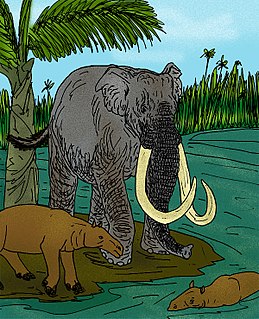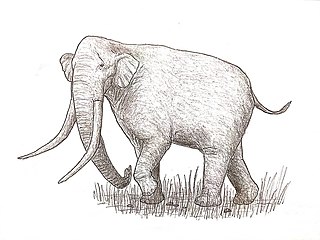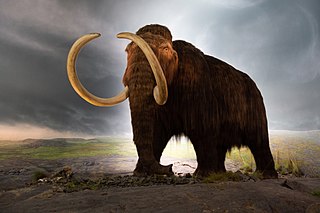 W
WA mammoth is any species of the extinct elephantid genus Mammuthus, one of the many genera that make up the order of trunked mammals called proboscideans. The various species of mammoth were commonly equipped with long, curved tusks and, in northern species, a covering of long hair. They lived from the Pliocene epoch into the Holocene at about 4,000 years ago, and various species existed in Africa, Europe, Asia, and North America. They were members of the family Elephantidae, which also contains the two genera of modern elephants and their ancestors. Mammoths are more closely related to living Asian elephants than African Elephants.
 W
WThe African mammoth, Mammuthus africanavus, is the second oldest mammoth species, having first appeared around 3 million years ago during the late Pliocene, with a last appearance around 1.65 million years ago in the early Pleistocene. Its fossils have been found in Chad, Libya, Morocco and Tunisia. It was relatively small and is seen as the direct ancestor of M. meriodionalis, although its tusk diverged more widely from its skull than later species of mammoth, which might indicate that it was an evolutionary dead end.
 W
WThe Columbian mammoth is an extinct species of mammoth that inhabited the Americas as far north as the Northern United States and as far south as Costa Rica during the Pleistocene epoch. It was one of the last in a line of mammoth species, beginning with Mammuthus subplanifrons in the early Pliocene. DNA studies show that the Columbian mammoth was a hybrid species between woolly mammoths and another lineage descended from steppe mammoths; the hybridization happened more than 420,000 years ago. The pygmy mammoths of the Channel Islands of California evolved from Columbian mammoths. The closest extant relative of the Columbian and other mammoths is the Asian elephant.
 W
WMammuthus creticus, or the Cretan dwarf mammoth, is an extinct species of dwarf mammoth. With a shoulder height of about 1 m and a weight of about 310 kg, it was the smallest mammoth that ever existed.
 W
WMammuthus meridionalis, or the southern mammoth, is an extinct species of mammoth native to Europe and Central Asia from the Gelasian stage of the Early Pleistocene, living from 2.5–0.8 mya.
 W
WMammuthus subplanifrons, the South African Mammoth, is the oldest representative of the genus Mammuthus, appearing around 5 million years ago during the early Pliocene in what is today South Africa and countries of East Africa, especially Ethiopia. They already presented some of the unique characteristics of mammoths like the spirally, twisting tusks. It was 3.68 metres (12.1 ft) tall at the shoulder and weighed about 9 tonnes. In 2009, it was shown that Loxodonta adaurora is indistinguishable from Mammuthus subplanifrons. The continuously decreasing length of vertebral spines from shoulder to hip and the extreme femur to tibia ratio indicate that this species belongs to Mammuthus, not Loxodonta, and since Mammuthus subplanifrons was named first, that would be the valid name for the species.
 W
WThe pygmy mammoth or Channel Islands mammoth is an extinct species of dwarf elephant descended from the Columbian mammoth of mainland North America. This species became extinct during the Quaternary extinction event in which many megafauna species became extinct due to changing conditions to which the species could not adapt. A case of island or insular dwarfism, from a recent analysis in 2010 it was determined that M. exilis was on average, 1.72 m (5.6 ft) tall at the shoulders and 760 kg (1,680 lb) in weight, in stark contrast to its 4.3 m (14 ft) tall, 9,070 kg (20,000 lb) ancestor. Another estimate gives a shoulder height of 2.02 m (6.6 ft) and a weight of 1,350 kg (2,980 lb).
 W
WThe existence of frozen soft tissue remains and DNA of woolly mammoths has led to the idea that the species could be recreated by scientific means. In 2003 the pyrenean ibex was revived, lending credence to the idea that the mammoth could be revived. Several methods have been proposed to achieve this.
 W
WThe steppe mammoth is an extinct species of Elephantidae that ranged over most of northern Eurasia during the late Early and Middle Pleistocene, approximately 1.8 million-200,000 years ago. It evolved in Siberia during the Early Pleistocene from Mammuthus meridionalis. It was the first stage in the evolution of the steppe and tundra elephants and the ancestor of the woolly mammoth and Columbian mammoth of the later Pleistocene. Populations of steppe mammoth may have persisted in northern China and Mongolia as recently as 33,000 years ago.
 W
WThe woolly mammoth is a species of mammoth that lived during the Pleistocene until its extinction in the Holocene epoch. It was one of the last in a line of mammoth species, beginning with Mammuthus subplanifrons in the early Pliocene. The woolly mammoth began to diverge from the steppe mammoth about 800,000 years ago in East Asia. Its closest extant relative is the Asian elephant. DNA studies show that the Columbian mammoth was a hybrid between woolly mammoths and another lineage descended from steppe mammoths. The appearance and behaviour of this species are among the best studied of any prehistoric animal because of the discovery of frozen carcasses in Siberia and Alaska, as well as skeletons, teeth, stomach contents, dung, and depiction from life in prehistoric cave paintings. Mammoth remains had long been known in Asia before they became known to Europeans in the 17th century. The origin of these remains was long a matter of debate, and often explained as being remains of legendary creatures. The mammoth was identified as an extinct species of elephant by Georges Cuvier in 1796.
 W
WThe woolly mammoth is a species of mammoth that lived during the Pleistocene until its extinction in the Holocene epoch. It was one of the last in a line of mammoth species, beginning with Mammuthus subplanifrons in the early Pliocene. The woolly mammoth began to diverge from the steppe mammoth about 800,000 years ago in East Asia. Its closest extant relative is the Asian elephant. DNA studies show that the Columbian mammoth was a hybrid between woolly mammoths and another lineage descended from steppe mammoths. The appearance and behaviour of this species are among the best studied of any prehistoric animal because of the discovery of frozen carcasses in Siberia and Alaska, as well as skeletons, teeth, stomach contents, dung, and depiction from life in prehistoric cave paintings. Mammoth remains had long been known in Asia before they became known to Europeans in the 17th century. The origin of these remains was long a matter of debate, and often explained as being remains of legendary creatures. The mammoth was identified as an extinct species of elephant by Georges Cuvier in 1796.